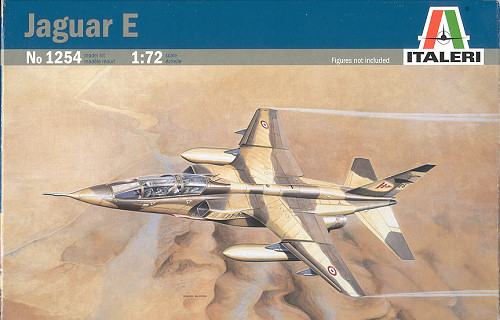
| KIT: | Italeri 1/72 Jaguar E |
| KIT #: | 1254 |
| PRICE: | $19.00 |
| DECALS: | Three options |
| REVIEWER: | Scott Van Aken |
| NOTES: |

| HISTORY |
"A total of 160 Jaguar A strike aircraft were delivered to the AdA beginning in 1973. At its peak, the Jaguar equipped nine AdA squadrons. The AdA obtained 40 two-seat Jaguar Es, for a total of 200 Jaguars of all types. They were initially delivered in dark green / dark gray camouflage with flat silver undersides.
The French found the Jaguar very handy for their running string of interventions in Africa. The aircraft was very capable, rugged, easy to maintain, and could be operated off of rough airstrips under primitive conditions. For desert combat, they were repainted in "sand and chocolate" camouflage. AdA Jaguars were the first to fire shots in anger, operating from Dakar, Senegal, beginning in December 1977 to perform attacks on Polisario insurgents fighting against the Mauritanian government.
Jaguars were then deployed to Chad in the spring of 1978 to perform strikes on Libyan-backed insurgents. After a political settlement in 1980, the French pulled out, only to return in 1983 and remain for a year when the fighting broke out again. Then, in 1986, the French returned once more to deal with an air base that the Libyans had built at Wadi Doum, in occupied northern Chad, to support insurgent forces. AdA Jaguars attacked the air base on 16 February 1986 with BAP-100 runway cratering bomblets, leaving a substantial mess behind. The Jaguars came back again on 7 January 1987, using Martel anti-radar missiles to hand out a similar rough treatment on Libyan radar stations around Wadi Doum.
AdA Jaguars, painted in two-tone sand camouflage, also served very well in the Gulf War, with the AS-30L laser-guided missile proving lethally accurate and effective. AdA Jaguars performed over 600 combat sorties during the active air war. No air-to-air kills were scored. One AdA Jaguar was damaged by a surface-to-air missile. It made it back to base but had to be shipped home on a cargolift aircraft.
After the Gulf War, the numbers of Jaguars in AdA service began a gradual decline. The nuclear strike role was dropped in September 1991, with that task taken up by the Dassault Mirage 2000N. The Jaguar did serve in French actions over the Balkans during the "wars of the Yugoslav succession" in the 1990s, but by 2001 it had been completely retired. "
Thanks to 'the internet' for this historical background.
| THE KIT |
 This makes the fifth 1/72 Jaguar kit following Airfix, Frog, Heller and Hasegawa. The Airfix, Frog, and Heller are the older of the group with the Hasegawa kit coming a few years after that. I have built both the Heller and Hasegawa kits and find the Hasegawa version to be the best of those four in detail and ease of construction. I've not had a chance to build the Airfix version.
This makes the fifth 1/72 Jaguar kit following Airfix, Frog, Heller and Hasegawa. The Airfix, Frog, and Heller are the older of the group with the Hasegawa kit coming a few years after that. I have built both the Heller and Hasegawa kits and find the Hasegawa version to be the best of those four in detail and ease of construction. I've not had a chance to build the Airfix version.
The Italeri kit has nicely engraved detail and minimal glitches. In fact, I found no sink areas, no flash and no nasty ejector pin marks during my initial examination of the sprues. Very nice. The cockpit has two fair seats and nice raised detail on the side consoles and instrument panels. Typical of many kits, the nose is a separate section so that the single seat aircraft can use most of the sprues. The canopy sections are nice and clear. They are also separate to view the cockpit. The refueling probe has a rather odd shape, but it quite usable.
The main landing gear are especially nicely detailed and there is good detail in the wheel wells. As is often the case, the speed brakes are separate so they can be posed in the lowered position as they usually were when on the ground. There are a ton of weapons but since this is the trainer version, none are used on this kit. Despite having five pylons, only the drop tanks are called for in the instructions. Actually, it was quite common to have clean wings so you may want to consider filling all the pylon mounting holes.
Instructions are very nicely done and provide complete color information. Markings for three aircraft are provided, differing only in the upper camouflage scheme as all three planes have silver lacquer undersides. You'll note from the photos that the undersides of the intakes are not in the underside color.
First is the box art plane in a three color upper camo of sand, medium and dark brown.
Next is one in sand and medium brown as shown below.


The third is the standard green and grey scheme.

Decals are nicely printed and should work just fine. Jaguars were generally light on data so not much is needed.
| CONCLUSIONS |
Nice to see this one. I'm not sure if it is a new mold, but I doubt it. Regardless, it is well done and should make for a most interesting addition to your collection of late 20th Century jets.
April 2006
Thanks to  for the review kit. You can find Italeri kits at your favorite hobby shop or on-line at www.testors.com
for the review kit. You can find Italeri kits at your favorite hobby shop or on-line at www.testors.com
If you would like your product reviewed fairly and fairly quickly by asite that has over 300,000 visitors a month, please contactme or see other details in the